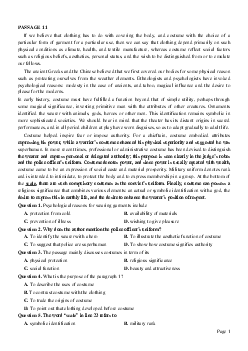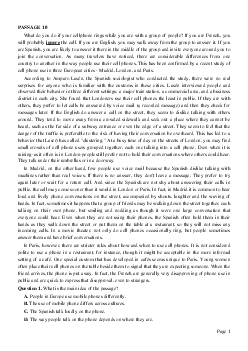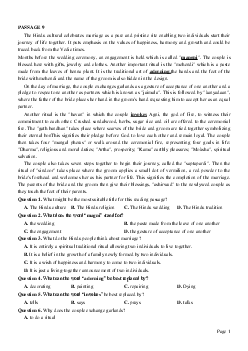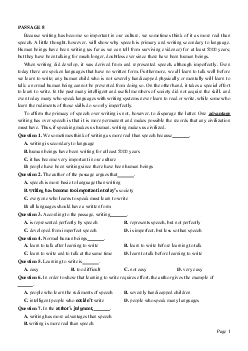


Preview text:
PASSAGE 6 LEVELS OF VOCABULARY
Most languages have several levels of vocabulary that may be used by the same speakers. In English,
at least three have been identified and described.
Standard usage includes those words and expressions understood, used, and accepted by a majority of
the speakers of a language in any situation regardless of the level of formality. As such, these words and
expressions are well defined and listed in standard dictionaries. Colloquialisms, on the other hand, are
familiar words and idioms that are understood by almost all speakers of a language and used in informal
speech or writing, but not considered acceptable for more formal situations. Almost all idiomatic
expressions are colloquial language. Slang, refers to words and expressions understood by a large number
of speakers but not accepted as appropriate formal usage by the majority. Colloquial expressions and
even slang may be found in standard dictionaries but will be so identified. Both colloquial usage and
slang are more common in speech than writing.
Colloquial speech often passes into standard speech. Some slang also passes into standard speech, but
other slang expressions enjoy momentary popularity followed by obscurity. In some cases, the majority
never accepts certain slang phrases but nevertheless retains them in their collective memories. Every
generation seems to require its own set of words to describe familiar objects and events.
It has been pointed out by a number of linguists that three cultural conditions are necessary for the
creation of a large body of slang expressions. First, the introduction and acceptance of new objects and
situations in the society; second, a diverse population with a large number of subgroups; third, association
among the subgroups and the majority population.
Finally, it is worth noting that the terms “standard”, “colloquial”, and “slang” exist only as abstract
labels for scholars who study language. Only a tiny number of the speakers of any language will be aware
that they are using colloquial or slang expressions. Most speakers of English will, during appropriate
situations, select and use three types of expressions.
Question 1. Which of the following is the main topic of the passage? A. Standard speech B. Idiomatic phrases
C. Different types of vocabulary D. Dictionary usage.
Question 2. How is slang defined by the author?
A. Words and phrases accepted by the majority of formal usage.
B. Words or phrases understood by the majority but not found in standard dictionaries.
C. Words or phrases that are understood by a restricted group of speakers.
D. Words or phrases understood by a large number of speakers but not accepted as formal usage.
Question 3. The word “appropriate” in paragraph 2 is closest in meaning to . A. old B. large C. correct D. important
Question 4. The word “them” in paragraph 3 refers to . A. words B. slang phrases C. memories D. the majority
Question 5. What does the author mean by the statement in paragraph 2: “Colloquialisms, on the other
hand, are familiar words and idioms that are understood by almost all speakers of a language and used
in informal speech or writing, but not considered acceptable for more formal situations.”?
A. Familiar words and phrases are found in both speech and writing in formal settings. Page 1
B. Familiar situations that are experienced by most people are called colloquialisms.
C. Informal language contains colloquialisms, which are not found in more formal language.
D. Most of the speakers of a language can used both formal and informal speech in their appropriate situations.
Question 6. Which of the following is true of standard usage?
A. It can be used in formal and informal settings. B. It is limited to written language.
C. It is only understood by the upper classes.
D. It is constantly changing.
Question 7. The author mentions all of the following as requirements for slang expressions to be created EXCEPT . A. new situations B. a new generation
C. interaction among diverse groups
D. a number of linguists ĐÁP ÁN 1-C 2-D 3-D 4-B 5-C 6-A 7-D
LỜI GIẢI CHI TIẾT Question 1: C
Đáp án C. Different types of vocabulary
Chủ đề chính của đoạnvăn là gì?
Câu chủ để của đoạn nằm ở 2 câu đoạn 1: “Most languages have several levels of vocabulary that may be
used by the same speakers. In English, at least three have been identified and described.” Hầu hết các
ngôn ngữ có nhiều cấp độ từ vựng cái mà có thể được sử dụng bởi cùng một người nói. Trong tiếng Anh,
có ít nhất 3 cấp độ từ vựng được xác định và mô tả.
Đáp án C: các loại từ vựng khác nhau.
Các phương án khác còn lại chỉ là một ý nhỏ của đoạn văn. A. Lối nói chuẩn. B Các cụm thành ngữ. D
cách sử dụng từ điển Question 2: D
Giải thích: Từ “slang” được tác giả định nghĩa như thế nào?
A. Những từ và cụm từ được đại đa số mọi người chấp nhận trong cách sử dụng trang trọng.
B. Những từ và cụm từ được đa số mọi người hiểu nhưng không có trong từ diển chuẩn mực.
C. Những từ và cụm từ được sử dụng chỉ bởi một nhóm người giới hạn.
D. Những từ và cụm từ được nhiều người hiểu nhưng không được chấp nhận trong lối nói lịch sự.
Dẫn chứng: “Slang, refers to words and expressions understood by a large number of speakers but not
accepted as appropriate formal usage by the majority” (Từ lóng, là những từ và thành ngữ được đại đa số
mọi người hiểu, nhưng lại không được đa số chấp nhận là cách sử dụng phù hợp trong trường hợp lịch sự.) => Chọn D Question 3: D Đáp án D. important
Appropriate = important: (a) thích hợp, thích đáng, quan trọng Page 2 Question 4: B Đáp án B. slang phrases
Thông tin nằm ở đoạn 3: “In some cases, the majority never accepts certain slang phrases but nevertheless
retains them in their collective memories.” Trong một vài trường hợp, phần lớn mọi người không bao giờ
chấp nhận một vài cụm từ lóng nào đó ngoại trừ việc lưu giữ chúng (cụm từ lóng đó) trong ký ức tập tập thể của họ. Question 5: C
Đáp án C. Informal language contains colloquialisms, which are not found in more formal language.
Thông tin nằm ở đoạn 2: “Colloquialisms, on the other hand, are familiar words and idioms that are
understood by almost all speakers of a language and used in informal speech or writing, but not
considered acceptable for more formal situations.” – Mặt khác, lối nói thân mật là những từ quen thuộc và
những thành ngữ mà được hiểu bởi tất cả những người nói ngôn ngữ đó và sử dụng trong văn viết cũng
như các bài phát biểu thân mật, nhưng không được chấp nhận ở các tình huống trang trọng.
Thông qua câu này, ý của tác giả là: Informal language contains colloquialisms, which are not found in
more formal language. – Ngôn ngữ thân mật bao gồm các lối nói thân mật, các ngôn ngữ này thì không
được tìm thấy ở ngôn ngữ sử dụng trong các tình huống trang trọng, nghi thức. Question 6: A
Đáp án A. It can be used in formal and informal settings.
Câu nào thì đúng để nói về cách dùng chuẩn?
Thông tin nằm ở dòng 1 +2 đoạn 2: “Standard usage includes those words and expressions understood,
used, and accepted by a majority of the speakers of a language in any situation regardless of the level of
formality.” Cách dùng chuẩn bao gồm các từ và cách diễn đạt được hiểu, được sử dụng và được chấp
nhận bởi hầu hết người nói của một ngôn ngữ trong bất kỳ hoàn cảnh nào bất kể mức độ trang trọng. Question 7: D
Đáp án D. a number of linguists
Tác giả đề cập đến tất cả những yêu cầu cho cách diễn đạt lóng được tạo thành ngoại trừ
Thông tin nằm ở dòng 2 +3 + 4 đoạn 4: “three cultural conditions are necessary for the creation of a large
body of slang expressions. First, the introduction and acceptance of new objects and situations in the
society; second, a diverse population with a large number of subgroups; third, association among the
subgroups and the majority population.” Ba điều kiện văn hoá cần thiết cho việc tạo ra cách diễn đạt lóng.
Thứ nhất, sự giới thiệu và chấp nhận những vật và hoàn cảnh mới trong xã hội, thứ 2, dân số đa sắc tộc,
thứ 3, sự kết nối giữa các nhóm dân tộc nhỏ và nhóm dân tộc chính Page 3




